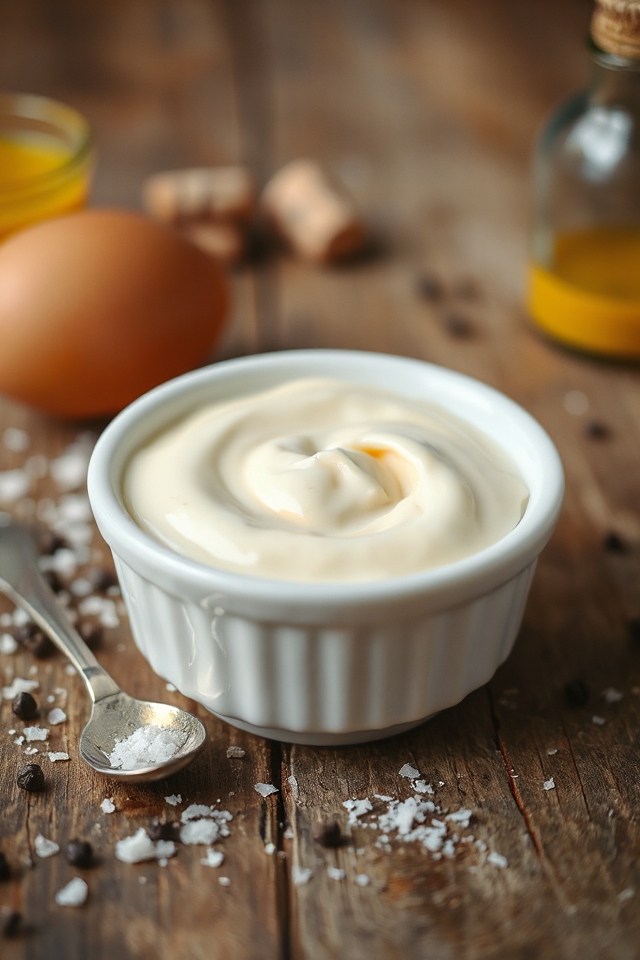Why You’ll Love This Homemade Mayo Recipe
If you’ve ever tasted homemade mayo, you know it’s a game changer. There’s just something about that creamy texture and rich flavor that store-bought versions can’t match.
When I whip up a batch, it instantly elevates my sandwiches, salads, and dips. I love how customizable it is, letting me experiment with flavors to suit my mood.
Plus, knowing exactly what’s in it gives me peace of mind. It’s quick to make, and I can control the thickness and tanginess.
Trust me, once you try this recipe, you’ll wonder why you ever settled for anything less. Enjoy the delicious difference!
Ingredients of Homemade Mayo
When it comes to whipping up a quick and easy condiment that can take your meals from drab to fab, homemade mayo is where it’s at. Seriously, there’s nothing quite like that fresh, creamy goodness you can achieve in just a matter of minutes. Plus, it’s super easy to customize! Want a hint of garlic or a kick of spice? You got it!
So, let’s plunge into what you need to get started on this culinary adventure.
Here’s what you’ll need for this delightful homemade mayo:
- 1 whole egg
- 1 teaspoon Dijon mustard
- 1 tablespoon vinegar (your choice—white, apple cider, whatever tickles your fancy)
- Salt
- Pepper
- 1 cup vegetable oil or canola oil
Now, let’s talk about the ingredients a bit more. First off, the egg is the magic ingredient that helps emulsify everything together, giving your mayo that luscious texture.
If you’re feeling fancy, you could even use a fresh farm egg for that extra special touch. The Dijon mustard not only adds flavor but also aids in the emulsification process.
And, about the oil—yes, you can choose between vegetable or canola, but if you’re feeling adventurous, try using olive oil for a different flavor profile. Just remember, the type of oil you choose will impact the taste, so pick one you love.
And don’t forget to season it! A little salt and pepper can go a long way in elevating your mayo to greatness.
How to Make Homemade Mayo

Alright, let’s explore the delightful world of homemade mayo. First things first, grab your trusty blender because we’re about to transform a few simple ingredients into creamy goodness.
Start by tossing 1 whole egg into the blender. This is the star of the show, so make sure it’s a good one—fresh is always best. Next, add in 1 teaspoon of Dijon mustard. Now, I know mustard isn’t everyone’s favorite, but trust me on this one; it helps emulsify the mayo and adds a lovely tang.
Then, throw in 1 tablespoon of vinegar—any kind you prefer will work. White vinegar, apple cider vinegar, whatever you have on hand will do just fine. Don’t forget a pinch of salt and a dash of pepper for flavor; you want your mayo to sing, not just whisper.
Once you’ve got everything in the blender, it’s time to blend it all together. Turn that blender on to a moderate speed and watch the magic happen as it starts to come together.
But here’s the tricky part—while the blender is running, you need to SLOWLY add in 1 cup of vegetable oil or canola oil through the little cap on the lid. This is where the emulsification happens, and if you pour it in too fast, your mayo might separate, which is a total bummer. Just take a deep breath and pour steadily; you got this.
In just a few moments, your mayo should be thick and creamy, and oh-so-delicious. Taste it, and if you feel like it needs a little more seasoning, go ahead and adjust with more salt or pepper.
Then, voilà! You’ve just made homemade mayo, and you can feel like a culinary rockstar. Enjoy it on sandwiches, salads, or even just on a spoon—no judgment here.
Homemade Mayo Substitutions & Variations
Exploring substitutions and variations for homemade mayo opens up a world of flavor and creativity.
For a zesty twist, I sometimes swap the vinegar for lemon juice or lime juice. If I’m feeling adventurous, I’ll add garlic for aioli or chipotle for a smoky kick.
Using olive oil instead of vegetable oil gives it a rich taste, and incorporating herbs like basil or dill can elevate the flavor profile.
For a vegan option, I’ve found that aquafaba, the liquid from canned chickpeas, works surprisingly well.
Each variation makes my homemade mayo unique, tailored to whatever dish I’m preparing!
What to Serve with Homemade Mayo
Homemade mayo pairs wonderfully with a variety of dishes, making it a versatile condiment in my kitchen.
I love using it as a spread on sandwiches or wraps, adding creaminess to my favorites. It’s fantastic with fresh vegetables, serving as a dip for crunchy carrots or bell pepper strips.
I also enjoy it on fish tacos, where it enhances the flavors perfectly. When I’m feeling adventurous, I whip it into potato or pasta salads, giving them a rich twist.
You can even drizzle it over grilled meats for an extra layer of flavor. Trust me, it elevates every dish!
Additional Tips & Notes
While making homemade mayo is straightforward, a few tips can enhance your results.
First, use room temperature ingredients; they emulsify better, creating a creamier texture. If your mayo doesn’t thicken, try adding a bit more oil slowly while blending.
For a flavor twist, experiment with different vinegars or add garlic for aioli. If you prefer a lighter mayo, substitute half the oil with Greek yogurt.
Finally, store your mayo in an airtight container in the fridge and consume it within a week for the best taste.
With these tips, your homemade mayo will be a delightful addition to any dish!